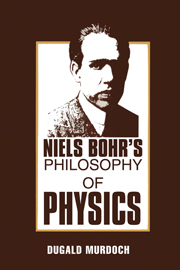Book contents
- Frontmatter
- Contents
- Dedication
- Preface
- Acknowledgements
- 1 Wave-particle duality
- 2 Niels Bohr and wave-particle duality
- 3 From duality to complementarity
- 4 The meaning of complementarity
- 5 The foundations of kinematic-dynamic complementarity
- 6 Bohr's theory of measurement
- 7 Bohr's theory of properties
- 8 Einstein versus Bohr
- 9 The sequel to the Bohr-Einstein debate
- 10 Bohr's philosophy of physics
- 11 An appraisal of Bohr's philosophy of physics
- Notes
- Index
4 - The meaning of complementarity
Published online by Cambridge University Press: 01 June 2011
- Frontmatter
- Contents
- Dedication
- Preface
- Acknowledgements
- 1 Wave-particle duality
- 2 Niels Bohr and wave-particle duality
- 3 From duality to complementarity
- 4 The meaning of complementarity
- 5 The foundations of kinematic-dynamic complementarity
- 6 Bohr's theory of measurement
- 7 Bohr's theory of properties
- 8 Einstein versus Bohr
- 9 The sequel to the Bohr-Einstein debate
- 10 Bohr's philosophy of physics
- 11 An appraisal of Bohr's philosophy of physics
- Notes
- Index
Summary
Bohr's general thesis of complementarity conveys the idea that we can, and perhaps must, make use of the classical physical concepts in quantum physics, notwithstanding the inadequacies of these concepts; but we can use them only within the limits circumscribed by the quantum of action – beyond these limits the classical concepts cease to be well defined. This idea originated in his thesis that the conceptual structure of the quantum theory is in a sense a generalisation of the conceptual scheme of classical mechanics; and this thesis was a corollary of the correspondence principle.
During the first months of 1927 Bohr regarded quantum mechanics as the quantum-theoretical generalisation of classical mechanics to which he had been looking forward. He came also to think that quantum mechanics required in a sense the generalisation of the two classical models of particle and wave. In classical physics these two models generally pertain to different theories, the particle model to the mechanical theory of matter, the wave model to the electromagnetic theory of radiation. In quantum physics, however, the two models pertain to one theory, quantum mechanics, and each is applicable to matter and radiation. Where discontinuity obtains, the standard classical models of matter and radiation cease to be well defined, and the alternative, non-standard models may be used. There is no logical inconsistency in this dual use of the models since each is appropriately applicable only in different empirical circumstances.
- Type
- Chapter
- Information
- Niels Bohr's Philosophy of Physics , pp. 57 - 79Publisher: Cambridge University PressPrint publication year: 1987



